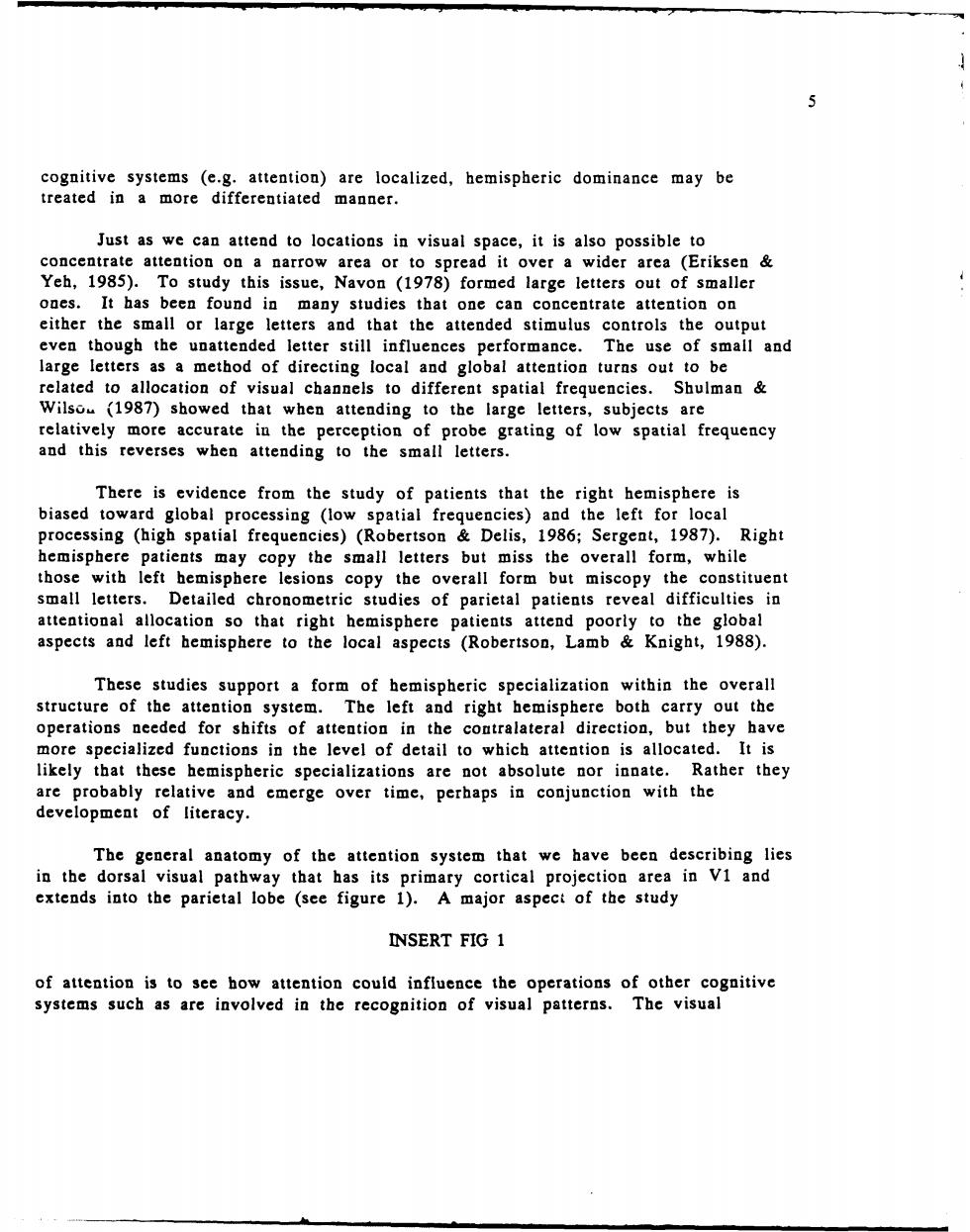正在加载图片...

5 cognitive systems (e.g.attention)are localized,hemispheric dominance may be treated in a more differentiated manner. Just as we can attend to locations in visual space,it is also possible to concentrate attention on a narrow area or to spread it over a wider area(Eriksen Yeh,1985). To study this issue,Navon (1978)formed large letters out of smaller ones.It has been found in many studies that one can concentrate attention on either the small or large letters and that the attended stimulus controls the output even though the unattended letter still influences performance.The use of small and large letters as a method of directing local and global attention turns out to be related to allocation of visual channels to different spatial frequencies.Shulman& Wilso(1987)showed that when attending to the large letters,subjects are relatively more accurate in the perception of probe grating of low spatial frequency and this reverses when attending to the small letters. There is evidence from the study of patients that the right hemisphere is biased toward global processing (low spatial frequencies)and the left for local processing (high spatial frequencies)(Robertson Delis,1986;Sergent,1987).Right hemisphere patients may copy the small letters but miss the overall form,while those with left hemisphere lesions copy the overall form but miscopy the constituent small letters.Detailed chronometric studies of parietal patients reveal difficulties in attentional allocation so that right hemisphere patients attend poorly to the global aspects and left hemisphere to the local aspects (Robertson,Lamb Knight,1988). These studies support a form of hemispheric specialization within the overall structure of the attention system.The left and right hemisphere both carry out the operations needed for shifts of attention in the coutralateral direction.but they have more specialized functions in the level of detail to which attention is allocated.It is likely that these hemis ecializations are not absolute Rather they are probably relative nd cmerge over time,perhaps in conjunction with the development of literacy. my of the atter system tha we have been describing lies in the do isual pat primary proje a in v1 and extends into the parietal lobe (sce figure 1). A major aspeci INSERT FIG 1 the operations of other cognitive visual patterns. visua 5 cognitive systems (e.g. attention) are localized, hemispheric dominance may be treated in a more differentiated manner. Just as we can attend to locations in visual space, it is also possible to concentrate attention on a narrow area or to spread it over a wider area (Eriksen & Yeh, 1985). To study this issue, Navon (1978) formed large letters out of smaller ones. It has been found in many studies that one can concentrate attention on either the small or large letters and that the attended stimulus controls the output even though the unattended letter still influences performance. The use of small and large letters as a method of directing local and global attention turns out to be related to allocation of visual channels to different spatial frequencies. Shulman & Wilson. (1987) showed that when attending to the large letters, subjects are relatively more accurate in the perception of probe grating of low spatial frequency and this reverses when attending to the small letters. There is evidence from the study of patients that the right hemisphere is biased toward global processing (low spatial frequencies) and the left for local processing (high spatial frequencies) (Robertson & Delis, 1986; Sergent, 1987). Right hemisphere patients may copy the small letters but miss the overall form, while those with left hemisphere lesions copy the overall form but miscopy the constituent small letters. Detailed chronometric studies of parietal patients reveal difficulties in attentional allocation so that right hemisphere patients attend poorly to the global aspects and left hemisphere to the local aspects (Robertson, Lamb & Knight, 1988). These studies support a form of hemispheric specialization within the overall structure of the attention system. The left and right hemisphere both carry out the operations needed for shifts of attention in the contralateral direction, but they have more specialized functions in the level of detail to which attention is allocated. It is likely that these hemispheric specializations are not absolute nor innate. Rather they are probably relative and emerge over time, perhaps in conjunction with the development of literacy. The general anatomy of the attention system that we have been describing lies in the dorsal visual pathway that has its primary cortical projection area in V1 and extends into the parietal lobe (see figure 1). A major aspect of the study INSERT FIG 1 of attention is to see how attention could influence the operations of other cognitive systems such as are involved in the recognition of visual patterns. The visual